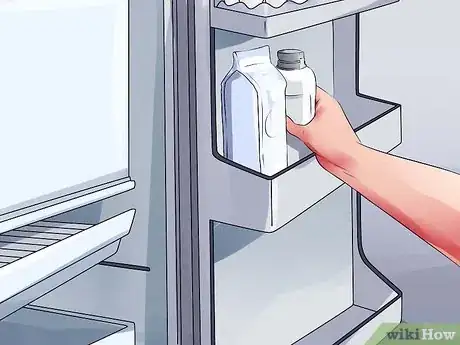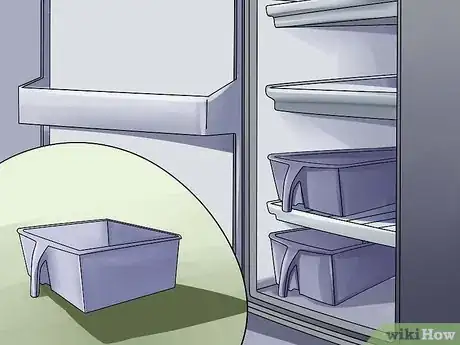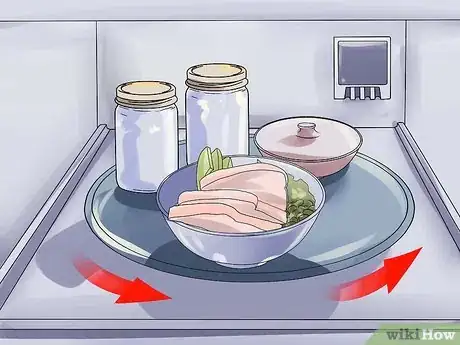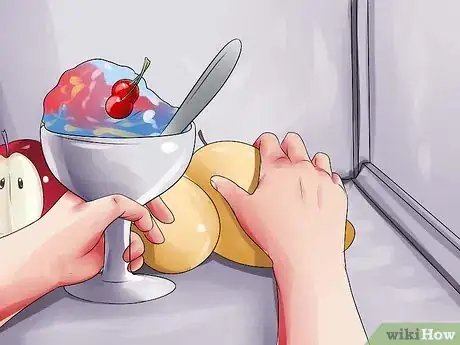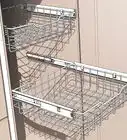This article was co-authored by Caitlin Jaymes. Caitlin Jaymes is a Closet Organizer and Fashion Stylist based in Los Angeles, California. With a background in Fashion PR and Fashion Design, she specializes in creating wardrobes for her clients with pieces they already own. She has experience working with celebrities, editorial shoots, and men and women of all ages. Caitlin uses fashion and organization to help instill and influence confidence, ambition, and stress-free lifestyles for all her clients. She runs her business by two guiding principles: “fashion has no rules, only guidance on how to look and feel your best” and “life has too many stressors, don’t let clutter be one of them.” Caitlin’s work has been featured on HGTV, The Rachael Ray Show, VoyageLA, Liverpool Los Angeles, and the Brother Snapchat Channel.
This article has been viewed 295,457 times.
Do you have a habit of filling up your refrigerator a little haphazardly after getting home from the grocery store, just sticking everything where you can squeeze it in? Organizing your refrigerator shelves will help you remember what items you have on hand and what's running low. Your food will also last longer if you store everything in the proper place, so you want have to throw away wasted food as often. You'll save money and time when you find the right place for your meat, produce, dairy products and condiments, using clever ideas to keep everything organized and fresh.
Steps
Organizing the Shelves
-
1Put your fruit in the low humidity drawer. Fruit keeps best when it isn't exposed to too much moisture. Most refrigerators have a special drawer that has the lower humidity than the other shelves and drawers. Sometimes it's labeled "low humidity," and other times it's labeled "crisper." This is where you should store your fruit, from apples to bananas to grapes.[1]
- If you're planning on eating fruit quickly, however, you may want to store it on the top shelf. Fresh berries, for example, will go bad faster than apples, so you might not want to store them in the crisper. Store the carton on the middle or top shelf, where you'll see it and reach for it before they start to shrivel.
- Produce stored in the crisper may be stored either loose or in open plastic bags. Don't store fruit in tightly-sealed plastic bags, since this can cause many types of fruit to rot more quickly.
-
2Keep your vegetables in the high humidity drawer. Most vegetables benefit from a little extra moisture - hence the sprinklers you see wetting down the produce section in the grocery store. Most refrigerators have a drawer that is labeled "high humidity," usually right next to the low humidity drawer. Store your whole vegetables there either loose or in open plastic bags to keep them fresh.
- If you're storing salad or cut vegetables, however, they'll go bad more quickly than vegetables that remain whole. For this reason, you should store them on the middle or top shelf and so you'll see them and use them quickly.
- To help vegetables keep longer, don't wash them before storage. Getting vegetables wet increases the chance that bacteria will grow and they'll begin to rot. Humidity is good, but you don't want the vegetables to be sitting in water. If you do need to wash them, dry them completely before storing.
Advertisement -
3Store meat in the coldest part of the refrigerator. Whether you need to store chicken breasts, steak, sausage, or turkey, it should go in the coldest part of the refrigerator. In most cases, that's at the back of the bottom shelf, although some refrigerators have a designated meat drawer. If you store meat on the top shelf, it's likely to go bad more quickly.[2]
- Make sure your meat is kept separate from the rest of the items in your refrigerator. It should be wrapped in plastic and stored as low as possible, so that if any juices escape other items won't get dripped on and contaminated.
- Clean the area where you store meat more often than you clean the rest of the refrigerator.
-
4Keep milk and eggs on the coldest shelf, too. Many people store milk and eggs on the door of the refrigerator for easy access. However, the door is the warmest part of the refrigerator, so storing them there will cause them to lose freshness faster. Store your milk and eggs on the bottom shelf, or whichever shelf is coldest in your refrigerator.[3]
- Unless you go through eggs quite quickly, it's better to store them in their original carton instead of transferring them to the egg containers on the inside of the door.
- Cream, buttermilk, yogurt, and similar products should also be kept on the cold shelf.
-
5Store deli meats and cheeses in the shallow meat drawer. If you have cold cuts from the deli, cream cheese, and other types of cheese, put them in the shallow meat drawer, which usually slides out from the middle or top shelf. This is also a good place to store bacon, hot dogs and other preserved meats. It's slightly cooler than the rest of the refrigerator, though not as cold as the back of the bottom shelf. Clean this drawer as regularly as you clean your other meat storage spot.
-
6Put condiments and drinks on the door. Condiments usually contain a lot of salt, vinegar and other preservatives that prevent them from going bad quickly, so it's fine to store them in the warmest part of the refrigerator: the door. Drinks also tend to keep longer than food. Designate the bottom shelf for the larger, heavier items, like orange juice, beer or soda. Put sweet condiments like jams, jellies and syrups on another shelf, and save the savory condiments like mustard and soy sauce for the last shelf.
- Even though butter is a dairy product, it's fine to store it in the butter compartment on the door. Butter doesn't need to be kept as cold as milk.
- If you're a condiment lover, it can be easy to let your condiment area get pretty messy with expired food. Go through the area regularly and toss out anything that's expired or mostly used up.
-
7Store leftovers and ready-to-eat foods on the top and middle shelf. Cooked food is fine to keep on the top or middle shelf. Use the the top and middle shelves to store any items that don't need to be kept especially cold: cooked baby food, pizza, dips and sauces, tortillas, and so on.[4]
- The top or middle shelf might also be the right place to keep a pitcher of water, medicine you need to keep cold, and other items that need to be cool, but won't easily spoil.
- To organize your refrigerator efficiently, remember to categorize the items.[5]
- Keep the things you need to grab and use quickly, on the top.[6]
- You can keep the things you do not use behind other things.[7]
Keeping the Refrigerator Clean
-
1Try using refrigerator baskets. Using baskets to organize your food is a great way to keep everything separate and accessible. You can buy baskets to store on your shelves and designate each basket for a different type of food. Label the baskets so you know what goes there. For example, if you buy a lot of cheese, you could have a separate basket just for cheeses.
- Baskets sized especially to fit in the door shelves are also available. Using baskets is a helpful way to keep condiments from getting too messy. When something spills, you can just remove the basket and clean it out.
-
2Use a lazy Susan. This trick is so useful, it's a wonder refrigerators don't come with lazy Susans already installed. Get a plastic lazy Susan (a circular spinning shelf) to put on the middle or top shelf of your refrigerator. Place items you're in danger of forgetting about, like leftovers, on the lazy Susan. This eliminates the common scenario of discovering months-old leftovers in the back of the fridge from time to time.
- It's also a good way to make sure you use up salad items, cut vegetables, fruit, and other items that tend to go bad quickly. Consider designating one lazy Susan for items you want to use right away.
-
3Consider lining the shelves for easy cleanup. Using shelf liners protects your food from getting contaminated and makes cleanup much easier. If you need to store meat on a shelf above your produce drawer, for example, having a plastic liner under the meat will prevent your produce from getting dripped on. Every week or two, just take out the liners and change them out for fresh ones.
-
4Purge your refrigerator often. Don't let expired items or moldy leftovers hang around and clog up your fridge. You'll end up having to squeeze fresh items in wherever they'll fit, which is a recipe for forgetting what you have on hand. Every week or so, go through your refrigerator and get rid of anything you're not going to use.[8]
-
5Don't store shelf-stable items in the refrigerator. Use your refrigerator to chill perishable items, and keep things like bottled water, cans of soda, extra condiments and other non-perishables in your pantry instead. This will make more room for the items that actually need to stay cold. Transfer your nonperishable to the refrigerator as you need them.
Arranging the Freezer
-
1Label everything before storing. If you're one of those industrious people who make a big casserole or batch of soup in order to freeze portions for later meals, make sure you label everything with the name and date. That way your food won't end up as a nameless, freezer-burned bag that you can't remember putting there several months ago. Keeping your freezer organized with labeled items will help you actually use up all the items you store there.[9]
-
2Put the items that store longest in the back. Make sure you know how long everything will keep in your freezer, then put the items that store longest in the back or bottom of your freezer. Items that need to be used more quickly should be kept toward the front, so you'll see them and use them.
- For example, frozen vegetables, fruit, meat and so on may keep for months or longer, so should be stored behind other items. This will prevent them from getting warmed up every time you open the freezer.
- Ice cream, popsicles, ice cube trays, and other items that you use up more quickly should stay near the front of the freezer.
-
3Use proper storage methods to prevent freezer burn. Frozen items don't tend to spoil, but freezer burn can still ruin their taste and texture, rendering them inedible. In addition to organizing your freezer so that the items that keep the longest are in the back, you should also use good freezer storage methods to protect the food from exposure to air and moisture. Use air-tight freezer bags or bins to store all items. Double-bag items that need to stay in the freezer for more than a few weeks.
- Storing items in flimsy sandwich bags doesn't protect them from getting freezer burn. Use thick freezer-safe bags instead.
Expert Q&A
-
QuestionHow do you arrange things efficiently in a refrigerator?
 Caitlin JaymesCaitlin Jaymes is a Closet Organizer and Fashion Stylist based in Los Angeles, California. With a background in Fashion PR and Fashion Design, she specializes in creating wardrobes for her clients with pieces they already own. She has experience working with celebrities, editorial shoots, and men and women of all ages. Caitlin uses fashion and organization to help instill and influence confidence, ambition, and stress-free lifestyles for all her clients. She runs her business by two guiding principles: “fashion has no rules, only guidance on how to look and feel your best” and “life has too many stressors, don’t let clutter be one of them.” Caitlin’s work has been featured on HGTV, The Rachael Ray Show, VoyageLA, Liverpool Los Angeles, and the Brother Snapchat Channel.
Caitlin JaymesCaitlin Jaymes is a Closet Organizer and Fashion Stylist based in Los Angeles, California. With a background in Fashion PR and Fashion Design, she specializes in creating wardrobes for her clients with pieces they already own. She has experience working with celebrities, editorial shoots, and men and women of all ages. Caitlin uses fashion and organization to help instill and influence confidence, ambition, and stress-free lifestyles for all her clients. She runs her business by two guiding principles: “fashion has no rules, only guidance on how to look and feel your best” and “life has too many stressors, don’t let clutter be one of them.” Caitlin’s work has been featured on HGTV, The Rachael Ray Show, VoyageLA, Liverpool Los Angeles, and the Brother Snapchat Channel.
Closet Organizer & Fashion Stylist To organize your refrigerator efficiently, remember to categorize the items. Keep the things you need to grab and use quickly on the top. You can keep the things you do not use behind other things.
To organize your refrigerator efficiently, remember to categorize the items. Keep the things you need to grab and use quickly on the top. You can keep the things you do not use behind other things. -
QuestionHow can I make decluttering enjoyable?
 Caitlin JaymesCaitlin Jaymes is a Closet Organizer and Fashion Stylist based in Los Angeles, California. With a background in Fashion PR and Fashion Design, she specializes in creating wardrobes for her clients with pieces they already own. She has experience working with celebrities, editorial shoots, and men and women of all ages. Caitlin uses fashion and organization to help instill and influence confidence, ambition, and stress-free lifestyles for all her clients. She runs her business by two guiding principles: “fashion has no rules, only guidance on how to look and feel your best” and “life has too many stressors, don’t let clutter be one of them.” Caitlin’s work has been featured on HGTV, The Rachael Ray Show, VoyageLA, Liverpool Los Angeles, and the Brother Snapchat Channel.
Caitlin JaymesCaitlin Jaymes is a Closet Organizer and Fashion Stylist based in Los Angeles, California. With a background in Fashion PR and Fashion Design, she specializes in creating wardrobes for her clients with pieces they already own. She has experience working with celebrities, editorial shoots, and men and women of all ages. Caitlin uses fashion and organization to help instill and influence confidence, ambition, and stress-free lifestyles for all her clients. She runs her business by two guiding principles: “fashion has no rules, only guidance on how to look and feel your best” and “life has too many stressors, don’t let clutter be one of them.” Caitlin’s work has been featured on HGTV, The Rachael Ray Show, VoyageLA, Liverpool Los Angeles, and the Brother Snapchat Channel.
Closet Organizer & Fashion Stylist You can put on some music or Netflix while decluttering. It will help to make the work more enjoyable.
You can put on some music or Netflix while decluttering. It will help to make the work more enjoyable. -
QuestionHow can I make it easier to find what I need in my fridge?
 Ashley Moon, MAAshley Moon is the Founder and CEO of Creatively Neat, a virtual organizing and life coaching business based in Los Angeles, California. In addition to helping people organize their best life, she has a fabulous team of organizers ready to de-clutter your home or business. Ashley hosts workshops and speaking engagements at various venues and festivals. She has trained with Coach Approach and Heart Core for organizing and business coaching respectively. She has an MA in Human Development and Social Change from Pacific Oaks College.
Ashley Moon, MAAshley Moon is the Founder and CEO of Creatively Neat, a virtual organizing and life coaching business based in Los Angeles, California. In addition to helping people organize their best life, she has a fabulous team of organizers ready to de-clutter your home or business. Ashley hosts workshops and speaking engagements at various venues and festivals. She has trained with Coach Approach and Heart Core for organizing and business coaching respectively. She has an MA in Human Development and Social Change from Pacific Oaks College.
Professional Organizer I like to organize my fridge so everything is sorted by function. For instance, I like to make a superfood smoothie every morning, so I'll keep all of those ingredients on my top shelf, then all of the condiments together, all the meal prep stuff on another shelf, and so on. Some people prefer to organize their foods by temperature, but this way, I always have a one-stop-shop for whatever I'm making.
I like to organize my fridge so everything is sorted by function. For instance, I like to make a superfood smoothie every morning, so I'll keep all of those ingredients on my top shelf, then all of the condiments together, all the meal prep stuff on another shelf, and so on. Some people prefer to organize their foods by temperature, but this way, I always have a one-stop-shop for whatever I'm making.
Warnings
- Uncooked meat should be stored on the bottom shelf, so it doesn't drip onto cooked food and give you food-poisoning.⧼thumbs_response⧽
References
- ↑ http://www.realsimple.com/home-organizing/organizing/kitchen/refrigerator-drawers-00100000087951/
- ↑ http://www.realsimple.com/home-organizing/organizing/kitchen/refrigerator-drawers-00100000087951/
- ↑ https://www.thekitchn.com/the-best-way-to-organize-your-fridge-tips-from-the-kitchn-48286
- ↑ https://www.thekitchn.com/the-best-way-to-organize-your-fridge-tips-from-the-kitchn-48286
- ↑ Caitlin Jaymes. Closet Organizer & Fashion Stylist. Expert Interview. 16 December 2019.
- ↑ Caitlin Jaymes. Closet Organizer & Fashion Stylist. Expert Interview. 16 December 2019.
- ↑ Caitlin Jaymes. Closet Organizer & Fashion Stylist. Expert Interview. 16 December 2019.
- ↑ http://www.goodhousekeeping.com/home/cleaning-organizing/declutter-your-fridge-guide
- ↑ http://www.goodhousekeeping.com/home/cleaning-organizing/declutter-your-fridge-guide
About This Article
To arrange refrigerator shelves, put fruit like apples and bananas in the low humidity drawer as they last longer with less moisture. However, place vegetables in the high humidity drawer, since they do better with a little more moisture. For meats like chicken or sausage, store them at the back of the bottom shelf, which is the coldest part of the fridge. You should also keep eggs and milk on the coldest shelf to stop them going bad. For tips on how to arrange your freezer and how to keep your fridge clean, keep reading!



